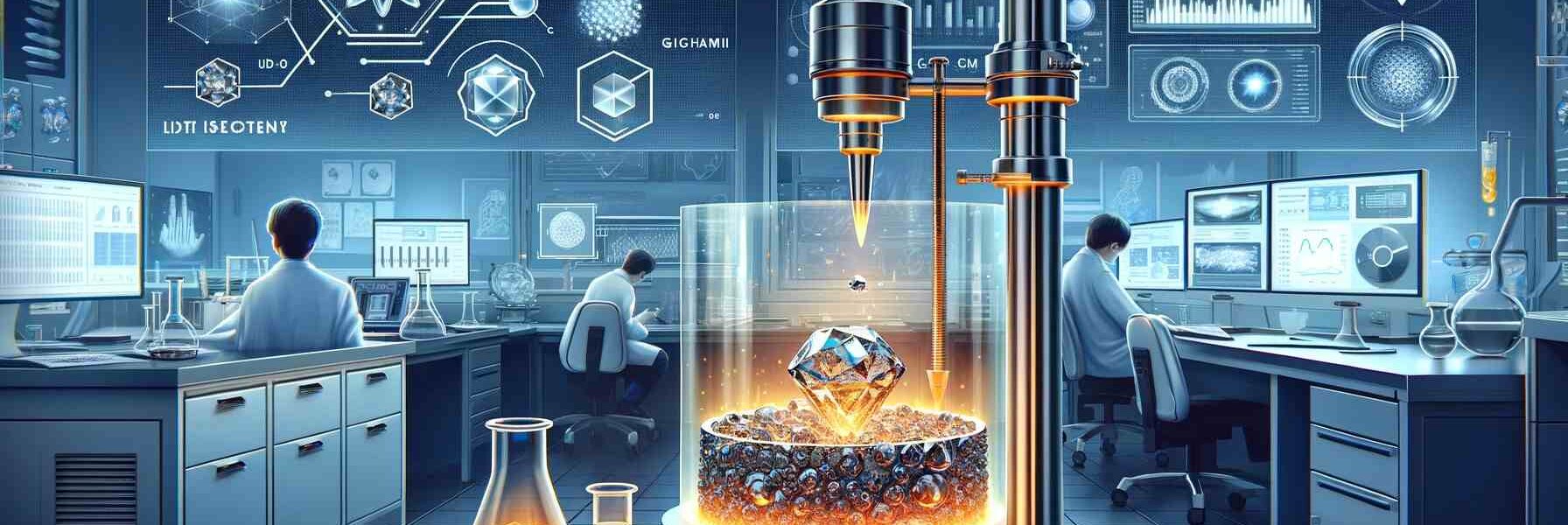Revolution in Lab Diamond Growth with Liquid Metal: A Paradigm Shift
TL;DR: Novel lab diamond growth method in liquid metal at ambient pressure offers significant implications for scientific research, scalability in industrial applications, and potential technological advancements.
This article examines a recent research article by Yan Gong and a team of researchers focusing on the lab growth of diamonds in liquid metal under 1-atmosphere pressure. This study could change how we grow lab diamonds, making the process easier and more efficient.
Article Contents
Introduction to Diamond Growth in Liquid Metal
At normal air pressure, researchers at the Institute for Basic Science under the direction of Director Rod RUOFF at the Center for Multidimensional Carbon Materials (CMCM) within the Institute for Basic Science (IBS) have created a new method to grow diamonds in liquid metal. This method could replace the traditional high-pressure and high-temperature techniques.
The study, with lead author Yan Gong, published on July 5th, 2023, explored a novel method for diamond growth without the use of seed particles, challenging the conventional high pressure and high temperature synthesis techniques traditionally associated with diamond formation.
Diamond, known for its exceptional hardness, thermal conductivity, and wide band gap, has long been synthesized using high pressure and high temperature (HPHT) methods that require very high pressure and heat. However, this new approach to lab diamond growth involved growing diamond crystals and polycrystalline diamond films at 1-atmosphere pressure and 1025°C at the interface of a liquid metal composed of gallium, iron, nickel, and silicon and a graphite crucible.
The researchers successfully produced diamonds using methane as the carbon source by diffusing carbon atoms in the subsurface region of the liquid metal.
This study’s significance lies in its departure from traditional diamond synthesis techniques, paving the way for diamond growth under milder conditions.
Liquid metals, known for their unique physical and chemical properties, were utilized as solvents and catalysts for diamond growth. The researchers optimized growth conditions by exposing the liquid metal to a methane and hydrogen mixture, forming diamonds in the temperature range of 1165°C to 1190°C.
- The study demonstrated the growth of diamonds at 1-atmosphere pressure without requiring high-pressure equipment.
- Various analytical techniques confirmed the diamond nature of the grown crystals, showcasing their potential for diverse applications.
- The role of different graphite interfaces in lab diamond growth highlighted the varying carbon contributions to the process.
This research opens up new avenues for diamond synthesis and underscores the potential of liquid metal-based methods for scalable and innovative diamond production. By expanding the understanding of diamond growth processes and properties, this study sets the stage for further exploration in the field of diamond technology.
Exploring the Novel Methodology
Director Rod RUOFF at the Center for Multidimensional Carbon Materials (CMCM) within the Institute for Basic Science (IBS), including graduate students at the Ulsan National Institute of Science and Technology (UNIST), has grown diamonds under conditions of 1-atmosphere pressure and at 1025 °C using a liquid metal alloy composed of gallium, iron, nickel, and silicon. This innovative approach challenges the traditional belief that high pressure and temperature are necessary for diamond synthesis.
By eliminating the need for seed particles, diamond crystals and polycrystalline diamond films were successfully grown at 1-atmosphere pressure and 1025°C. This unconventional technique took place at the interface of liquid metal, consisting of gallium, iron, nickel, and silicon, and a graphite crucible. The process involved catalytic activation of methane and the diffusion of carbon atoms within the subsurface region of the liquid metal.
- Description of Liquid Metal Interface: Diamond crystals grew at the interface of liquid metal and a graphite crucible, marking a significant departure from conventional diamond synthesis methods.
- Catalytic Activation of Methane: Methane played a vital role as the carbon source for the newly grown diamond regions, as confirmed by Raman spectroscopy with 13C-labeling.
- Characterization Techniques Used: Various advanced analytical techniques such as Raman spectroscopy, scanning and transmission electron microscopy, X-ray diffraction, and photoluminescence were employed to meticulously characterize the newly grown diamonds, revealing their unique properties and structures.
This study not only expands the scientific understanding of diamond synthesis but also unveils new possibilities for future research and applications in the realm of diamond technology. By exploring the lab growth of diamonds in liquid metal under ambient pressure conditions, the researchers have opened doors to further exploration of diamond growth using alternative methods and carbon sources.
Results and Discussion: Insights into Diamond Growth
Yan Gong from the Center for Multidimensional Carbon Materials (CMCM) at the Institute for Basic Science (IBS) and a team of researchers conducted research on diamond growth in liquid metal at 1-atmosphere pressure, and the results are fascinating. The unconventional approach of growing diamond crystals and films without seed particles challenges the traditional high pressure and high-temperature synthesis methods. The team’s method involves using liquid metal as a solvent for carbon to grow diamond crystals and films, which could potentially revolutionize the industry of labgrown diamonds. The research opens up the possibility of producing high-quality diamonds at a lower cost and in a more sustainable manner. This breakthrough could also lead to advancements in various fields such as electronics, optoelectronics, and quantum information processing.
“This pioneering breakthrough was the result of human ingenuity, unremitting efforts, and the concerted cooperation of many collaborators.”
Director Ruoff, who is also a UNIST Distinguished Professor
The utilization of a liquid metal alloy consisting of gallium, iron, nickel, and silicon in a custom-built cold wall vacuum system has proven to be pivotal in the controlled growth of diamonds. By exposing the liquid metal to a methane and hydrogen mixture at 1 atm pressure, diamonds were observed to form at the interface with graphite crucibles or thin graphite sheets.
Parametric studies were undertaken to optimize the growth conditions, leading to the most significant diamond formation in the specific atomic percentage mix of gallium, nickel, iron, and silicon at 1175°C. The size and density of diamond crystals were found to increase with longer exposure times, resulting in continuous diamond films that possess optical transparency and a polycrystalline structure.
Moreover, the researchers delved into the influence of various graphite interfaces on the diamond growth process in liquid metal. By utilizing different graphite materials, they demonstrated the selective growth of diamonds from 13C-labeled methane, shedding light on the diverse carbon sources contributing to diamond formation.
The study confirmed that the grown crystals were diamonds using many different analytical methods, such as atomic force microscopy, transmission electron microscopy, X-ray diffraction, and Raman spectroscopy. The findings expand the understanding of diamond synthesis and pave the way for further exploration of diamond growth using liquid metals and alternative carbon sources.
This groundbreaking research into lab diamond growth signifies a paradigm shift in diamond growth methodologies, offering new possibilities for both scientific research and potential applications in diamond technology. The study opens avenues for future investigations into the scalability and versatility of diamond growth using liquid metal alloys.
Analyzing the Impact and Future Possibilities
Exploring the growth of diamonds in liquid metal under ambient pressure and moderate temperature has opened up new avenues for scientific research and technological applications. This innovative approach challenges traditional high-pressure methods and offers intriguing possibilities.
Implications for Scientific Research
The successful growth of diamond in liquid metal at 1 atmosphere pressure signifies a significant breakthrough in diamond synthesis. By circumventing the need for high pressure and temperature, researchers have broadened the horizons of diamond production, paving the way for further exploration in materials science and crystal growth mechanisms.
Scalability of Diamond Growth Method
The scalability of this novel lab diamond growth method presents exciting prospects for industrial applications. The ability to grow diamonds under milder conditions using liquid metals enhances production efficiency and offers potential cost-effective and sustainable alternatives to traditional synthesis techniques.
Potential Applications in Technology
The unique properties of diamonds, such as exceptional hardness and thermal conductivity, make them valuable materials for various technological applications. The newfound ability to grow diamonds in liquid metal under ambient pressure opens doors for innovations in electronics, quantum computing, and other cutting-edge technologies.
Lab Diamond Growth Might Change Forever!
In conclusion, Yan Gong and his team’s innovative research marks a significant breakthrough in the field of lab-grown diamonds. This study challenges traditional high-pressure, high-temperature methods by successfully growing diamonds in liquid metal at 1-atmosphere pressure and moderate temperatures. This new approach simplifies the diamond synthesis process and opens up exciting possibilities for scalable and cost-effective diamond production. With potential applications ranging from electronics to quantum computing, this pioneering work sets the stage for future advancements in diamond technology, promising a brighter and more efficient future for the industry.





3 COMMENTS